[home]
Interview with buZ blurr - 09/12/08
As I'm typing this buZ blurr and graffiti artist Take5 are on the road heading to San Francisco for the opening reception of Two Sides to Every Boxcar, an exhibtion of buZ's artwork here at Babylon Falling.
The following interview is from a phone conversation I had with buZ this past Friday. We talked about a lot and the topics covered follow the general chronological trajectory of his life. Aside from providing glimpses into his past the stories and anecdotes buZ relates are pure Americana. It's a lot to read so I'll leave the introduction at that. Enjoy and don't forget to make it out to the opening reception and discussion this Saturday, September 20th from 6-9pm right here in the store.
Where are you right now?
I'm at my home in Gurdon, Arkansas.
Is that where you were born and grew up?
I'm a third generation railroad man and moved all over the system, all over Arkansas, Louisiana, and Texas. My father’s career was track maintenance; he was a minor official, and he finally ended up in his career in this small town. He got me a job on the railroad as a brakeman…so I've been here ever since I graduated high school. I've been living here since 1959.
I’ve read where you said there was a 10-year gap between when you started doing any of the boxcar monikers, and I’m wondering what was going on in those years between when you started on the railroad and when you started doing the monikers. What was it that kept you from doing it for those 10 years?
I hired out in ‘62 and didn't start marking the cars until November ‘71. So that nine-year interim I was working various night jobs, and I had given up my idea on any kind of art, and had started reading novels like Vonnegut’s; all his greatest novels featuring his Kilgore Trout character--a writer that didn't have readers, but he continued writing compulsively. I was also reading ‘Understanding Media’ by McLuhan, RD Laing’s ‘Politics of Experience,’ and those other heavy thinkers like Skinner and the conditioned response of his experiments and all that. So during all this time I had been in an afternoon job--it was one of the first times I'd had a regular daylight job--and most times I was working at night on switch engines and locals. So on this job I was working what they call the long field position, and I was down in the yard--the rail yard was downhill--and I had to keep the tracks from rolling out the north end so I had to keep the head brakes tied down on all the rails. So after I had that done, I was just laying down in amongst the cars to make certain they didn’t roll out. I had some free time so I decided to be a vandal myself, you know?
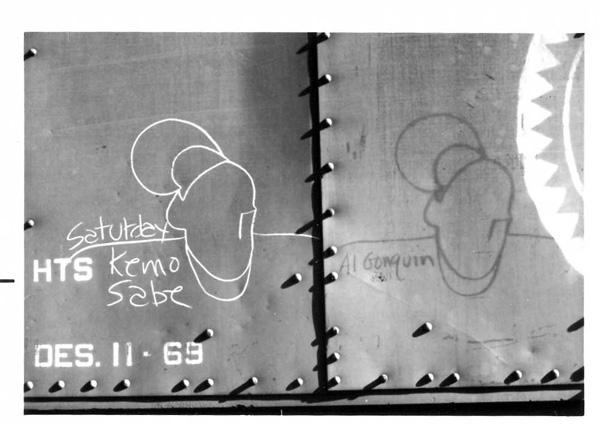
Gypsy Sphinx. Photo © buZ blurr
Was it planned? The Gypsy Sphinx character, had you been drawing that at home, sketching it? Had it been around in your life before that night, or had it been a spontaneous thing?
That character, that's one of the problems. That original character I had was based on a caricature of a real person that worked in the yards and was well known amongst the rail personnel. I had been doing a running cartoon of incidences and occurrences that were going on around the railroad and just, you know, had a depot copier, and so I was making drawings and using real people, and then people Xeroxed them and passed them around and all that. So it was the people that were featured in these drawings, I soon learned, [who] were finding objections to being the subjects to these comic observations about what was going on. I didn't have an audience--or I had a hostile audience--so I had to suspend that. Then the other character didn't seem to mind, he was kind of like the laughing stock anyway, so I used a somewhat stylized characterization of him, but I kept trying to get away from that hangdog comic look of it and tried to make it more heroic so it would be less identifiable to a particular person. It kind of evolved and I tried to push it around and finally, just like with that Gypsy, I finally gave up and decided I'd have to come up with another character if I wanted to continue. So I was doing research on the practice of what I call branding, hobo moniker tradition, folk art tradition of chalking the cars, and discovered that Bozo Texino person in that pipe-smoking-cowboy image of Bozo Texino. So I'd been doing some doodling in my sketch book and kind of came up with a character that looked similar to the Bozo Texino, so I decided to go with that character, but I wanted to give a sign-off to the previous character. So I did a year of Gypsy Sphinx as the definitive identity of that initial icon while I practiced that other one. In ‘79 when we moved to my current home, that's when I started doing the rider motif to the basic Bozo Texino icon. Of course when I first started off, I was just putting a name and the date, and a date didn't seem to recall anything about what was going on, so I started using names as captions, anecdote titles, and alter egos. It was kind of like a memory nudge prompt to recall what I was thinking.
Was drawing the moniker first and foremost for you then?
Really people...it would all be conjecture about what it meant ‘cause I mean, they couldn't possibly know for certain what it did mean, you know? Unless it was related to something that they were aware of...so I mean, there were some references that I made that were identifiable and recognizable to the local people, but strangers couldn't identify them...so that language that I would use, particularly for myself for a prompt/recall, turned out to be the main appeal of the character. The esoteric or cryptic language prompted people's heads to read some meaning into the passage. Basically, since that whole moniker tradition is to put a name and date on there so it's a continual static icon, it just has a name and date so that language apparently added an appeal to the drawing.
That I have a bookstore is the most unlikely of outcomes anyone could have predicted...I'm curious to know, what was your introduction to reading?
My deal is...when we was moving around with dad's job, it seemed like every year he'd be transferred to another job down the line. When I was in the ninth grade, I was engaged to be married to an eighth grader, so when we moved from that town in Arkansas to Palestine, Texas, they allowed me every weekend to go on a passenger train. Every Friday night I 'd ride from 7 pm to 9 o’clock the next morning to see my girlfriend. At that time, Missouri Pacific had a really extensive passenger service just about system-wide, so you'd just take a train anywhere on the line. When I was in the tenth grade, I was going back riding the train and I bought ‘On the Road’ by Jack Kerouac...so I was hooked on that Beatnik aesthetic. I finally had an excuse for being a lame student...so I got real enthused about the bop prose of Kerouac and I started reading all his novels. My deal is I was too young to be a Beatnik and too old to be a Hippie. I was reading, in particular, the Beat writers: John Clellon Holmes, Kerouac, and Burroughs in high school.
Did you ever have anyone to talk about the books with at that time?
Yeah, I had an English teacher in tenth grade that tried to be a Hipster Beatnik dude, but stayed employed in an east Texas conservative city. He was telling classes what books to read, and he was writing a novel himself about Caligula.
Have you kept in touch with him?
No. He got a job further out in west Texas. He had people that were interested in the Beat movement. He'd always buy the most recent records, so a lot of kids hung out over there, and of course he'd talk about art and all that too. And of course I was also reading biographies and had built up a romantic notion of artists, and that kind of fueled my Beatnik romanticism too.
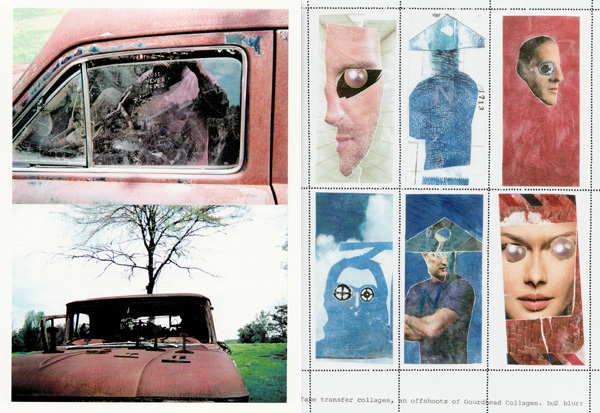
© buZ blurr
What is your background with art? Are you completely self taught?
No. I went to college for three years...they didn't have art classes in Gurdon High where I graduated, but I took art in Monroe, Louisiana--I went to school there. So then when I went to start local college here, 16 miles north of here, at Henderson State Teacher's College at the time, subsequently it's Henderson State University. I took art classes then...you know drawing and painting, ceramics and pottery. I was an art major, working on my minor in psychology and I was going for a B.A. degree and needed two years of foreign language, and French was my stumbling block in that my dad had got me a job on the railroad working the summer. At that time, most of the guys...the railroad was busy and had a lot of people working, and most of the guys wanted to take their vacation in the summer, and so I got a job to work summers. At that time if you hired out you had to join the union...so you had union representation, but as it worked out all the vacation would end and then you'd be cut off anyway when all the guys came back from their vacations...you'd go to school on the earnings you'd made off summer workings. By the time I got to be a junior, the Vietnam War was cranking up big time.
What year was this?
'64…around October '64. The railroad gave me [an] ultimatum: they wouldn't give me a leave of absence to continue school. The business kicked up on the railroad; increased business due to the activities of the war...cranking up the war machine. The railroad gave the ultimatum to either mark up or they would fire me. I dropped out of school to work and make some money. When I dropped out of school I lost my student deferment and was classified 1A and subject to the draft. My wife, my girlfriend at the time, was a senior in high school. By this time it was December and I was called up for pre induction. We were planning to get married when she finished high school the following spring, so we upped our plans and got married Christmas eve of ’64. At that time they weren't taking married men, so that forestalled my induction for the draft. But being married like that, I was pretty well hooked up to staying working and finding a home and shelter and whatnot. So I continued to work, and then they decided to take married guys. We had our first child on the way, and that forestalled another draft. And of course they decided to take fathers with one child and we had another on the way...so anyway, with the three kids, the idea of [an] art career...and the railroad paid about as well as anything in Arkansas. So that very well committed me to the lifestyle of a railroad man and family man...oh well. My parents had divorced, and I didn't have any support. I was renting a small house and going to school and living off my summer earnings, and given that I was such a lame student of preached language, that influenced my decision to go back to work.
While you were doing the monikers were you still doing artwork at home?
I was still sketching the kids and the misses, and [doing] some watercolors. But the railroad work was so pervasive...at that time they were working jobs 16 hours, the maximum allowable by law. At that time I was working 16 hours a day and six days a week, so it didn't allow for a lot of free time.
What was your introduction to photography?
One of my professors brought an exhibit of Robert Frank's American photographs to a gallery there at school. That was really impressive to me to see Robert Frank in ‘62 and ‘63. I've always been interested in photography, but the only kind of cameras I could afford were the cheap ones.
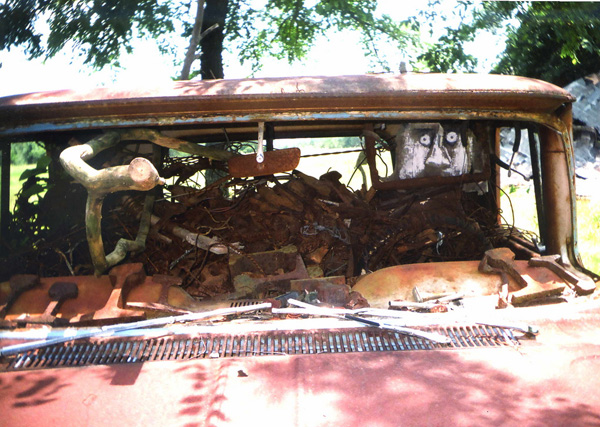
Rust Never Rests. Photo © buZ blurr
Do you remember your first ever camera?
I was with my folks. They were giving away little plastic cameras in Mississippi. We went to a Mercury place to look at cars, and we marked up for a little prize drawing and we won a little plastic camera. So I took a lot of pictures when I was in sixth and seventh grade with that little black and white camera. In one of our moves, our multiple moves, the camera got displaced and I found other interests like literature.
And then when did you rediscover photography?
Well, we bought a little Polaroid...and even then we had to wait payday to payday, which was twice a month, to buy a package of film. But that also lead to experimenting...I was an image hoarder. I was an image junkie. You know when you peel the image sandwich apart on the black and white Polaroid, you know, the negative? It seemed like a waste to throw it away even though Polaroid cautioned you to discard it because the developing fluids in the emulsion would cause alkaline burns, what they call caustic jelly. So I started retaining those and using them as a guide to cutting a stencil directly into the negative with a Xacto knife. The back of it was like a photographic negative, and the back of that is what is actually exposed through the lens. And then when it goes through the roller, then it transfers to the actual print you know. When you cut a stencil using that guide and turn it over on its back, then you have a graphic positive. So [with] that technique, when I discovered the Mail Art network and the artistamps, I started taking pictures of other people. And to have any kind of detail I have to get real close, kind of like a severe, up-close, distorted mug shot. Then I took the stencil, and on the depot copier I'd Xerox it and through reduction I'd put them on a postage stamp. I became known in the Mail Art world as an artistamp person who did portraits.
I'm curious to know how you discovered the mail art world.
Actually, during those interim years where I was encouraged to seek some kind of avenue of expression myself, I was doing a lot of reading, and of course I was subscribing to Rolling Stone magazine. In the April 19, 1972 issues--two consecutive issues in April of ’72--the art critic of the San Francisco Chronicle had an article in there about correspondence art. His name was Thomas Albright and he highlighted all these various people that were doing networking and plugging in using the postal system--and they was doing it globally. The Fluxus people were corresponding in Europe, New York, and other places in the United States, so the whole article highlighted that. They also highlighted Ray Johnson who was one of the original persons who used the mail system to connect other people. He was doing these introductions, or connections, and he was using the mail in that way to connect various people in the New York scene with other people in other places, you know. So the whole article, those two consecutive articles, were about these people that were doing this networking or conceptual art...networking as an idea. In that--of course this was in April of '72 and I had consciously decided to participate as a vandal in the rail network in November of '71--so I thought I was a conceptualist myself, you know. When the Rolling Stones album, Exile on Main Street, came out, it had a lot of Robert Frank photographs, and included a series of postcards. So I just mailed all those postcards from that album to all those people listed in the article, with just my return address. The response to that mailing subsequently led to my enthusiasm for receiving art in the mailbox, you know, so that kind of plugged me in to another avenue of expression. I was using the North American rail system as a communication of randomness, and here was another form of communication that could be more specific.
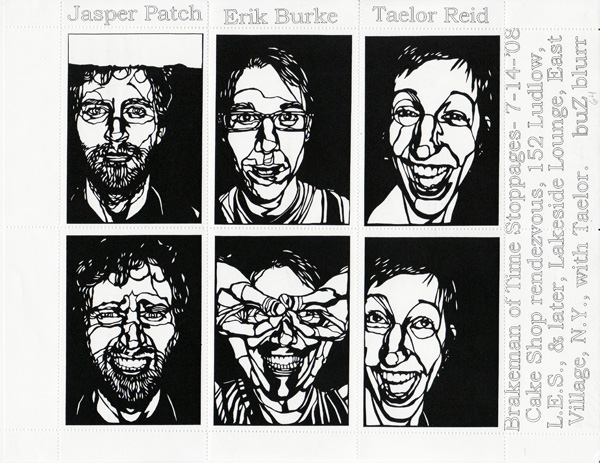
"New York Muggings." Stencil Portraits. © buZ blurr
Was there ever a crossover between the worlds? Did you ever do the Colossus of Roads moniker with a reference to something going on in the mail art network or vice versa?
Yeah, in ‘81 I did what I call a clack click graffiti stamp project. I decided that using the criteria of chance, that if someone made contact not initiated by me and I had never heard from them before, I would send them an invitation to send a collage, or anything I could do on the side of a boxcar, and I would glue it to a car...a collage or photograph or whatever they decided to send, I would photograph it and they would receive a stamp sheet composed of all the contributors plus a computer print out of the destination of the car subsequent to the application of their artwork. This was subsequent to 1980, when I went to San Francisco to see Cavellini. He was a rich, Italian businessman, and he started--he discovered--the mail art network, and started doing books about his life and his performances. He was also doing artistamps, and so if you wanted on his mailing list, all you had to do was send him something in the mail, and he'd start sending his full-color books about his life. It seemed like he was putting one out every month. So once you got on his mailing list, you started getting all these books...anyway, Cavellini had a big following, and like you say, it seemed like a closed, small network at the time he came to California--to San Francisco initially--so I went out on a train to meet him. His concept was Autostoricizzazione, which is “every life is unique.” So if you're an artist or want to be an artist, all you had to do was document your own life and do the same thing he was doing, which was to tell your story. Which, in his particular way, was through performances. He would write, he'd do performances in Europe, and he'd have a nude female and a nude male, and he'd write anecdotes from his life and parts of his autobiography on their body as part of his performance--he wrote in a real elaborate script on his suit. He came to San Francisco, and I went out on the train, and up in Ukiah they had a big festival to celebrate Cavellini. They had a parade and everything--he was king of the parade--and they built a big throne for him and all that. He also sent…he had these Cavellini stickers that were silver, red, and green colors, the colors of the Italian flag, and they had 'Cavellini' and the dates 1914 – 2014, which was another contention of his, that the people wouldn't realize Cavellini was a genius for 100 years, and then at the end of 100 years, he'd be venerated for his invention of Autostoricizzazione. So that was part of my Autostoricizzazione, my trip to meet Cavellini in San Francisco. Then Anna Banana and Bill Gaglione were living in San Francisco, on Church Street at the time, and that's where they had big gathering of artists from California and other places. That was where I met Cavellini. Went up to Ukiah and stayed at the Palace Hotel there. They had performances in the basement. He did a performance of…they nixed the idea of him riding on nude bodies, but they did have a bikini clad girl and a jock strap guy.
And the whole time you were documenting this?
Yeah, through photographs.
And you said earlier you're an image hoarder? So...
I got crazy, crazy slides...so you know? The cheapest route for me is the black and white imagery. If you're going to do a lot of mailing around, Xerox is the cheapest way to go. Or postcards.
Do you keep everything that you've been sent through the mail art network?
Yeah, I got a room in the back of my house. I started off with a...it seemed like everyone always had an alias in the mail art network...like Anna Banana and Bill Gaglione were Dada Land, and you know, all these various people that had aliases or alter egos, so I came up with Hoo-Hoo Archives as a kind of false advertisement that I had the wherewithal to categorize the mail and the stuff that came in it. Anyway, so I was known as Hoo-Hoo Archives initially when I first got plugged in with the mail art network, and I took it from the marquee of a theatre in this town. When I was doing those train journeys back and forth, I'd pass through this town all the time that had the Hoo-Hoo Theatre. But the Hoo-Hoo Theatre came from a Hoo-Hoo government organization, which was organizing in town. They got stranded in the hotel here in Gurdon and they all got inebriated and formed this organization called Concatenated Order of Hoo-Hoo, and it was kind of like a comical extrapolation of the various secret societies--but it was done more in fun. When I took the Hoo-Hoo Archives, I didn't realize that the Hoo-Hoo organization was still extant. So subsequent to that, I had to get away from using Hoo-Hoo.
Similar to Cavellini, is the overall purpose just to document your life?
Yeah, essentially it's self-promotion you know...
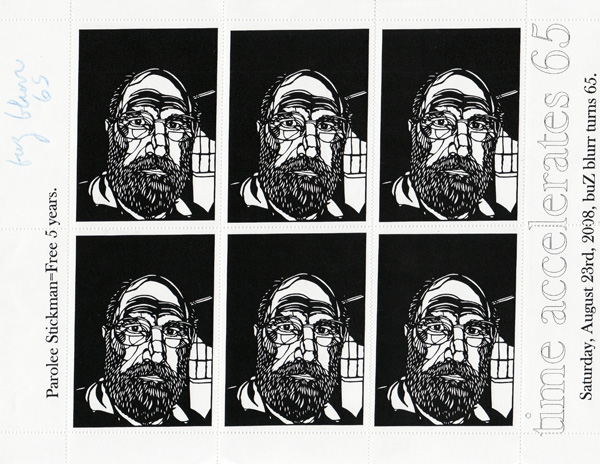
Self Portrait © buZ blurr
So that's the link to the modern-day graffiti artists?
Yeah, he was criticized for that. Not only was he an artist, he was the “world's greatest artist,” you know? So I mean, of course that's the whole deal...a lot of people realized hey, if you're going to be an artist, why not be the greatest artist? Supposedly Cavellini had already taken up that position. It's all similar to that whole Warholian idea of 15 minutes of fame. Fame is what makes you significant or important, or what validates you as an artist. It's like Duchamp says, “An artist exists only if he's known.” So you gotta get out there. To me it's like this guy gets it, that's what we're all about, but I mean, he's got the money to do it. Anybody that's on his mailing list, he's going to start sending them books. That was my promise to Cavellini…to ride the train to California to meet him.
With the modern-day graffiti artists and the moniker tradition, your stuff still stands out. With your stuff, the aesthetic seems to be more complex than just fame, and it sits in this weird middle ground where it touches many things but is none of them. And I was just curious to know how you see yourself, your place along the line.
I mean I tried to...I initially started off not being--of course this was prior to Basquiat and Haring and all of them and the whole New York/Philadelphia explosion of subway graffiti--when I started in my initial emulation of the folk art tradition of monikers. But the longer I did it, the more it was evolving and I started using language and adding to it in that direction to try to have a variation on the static icon that it had accompanied. I thought I was, hopefully I was elevating it beyond that mere one dimension of the moniker, to a general performance art and an awareness of contemporary aesthetics and post modernism...from just reading and staying current. So yeah, I was hoping to elevate it beyond the mere competiveness of what it really is. I might have been delusional, but anyway, it was also my inspiration too you know.
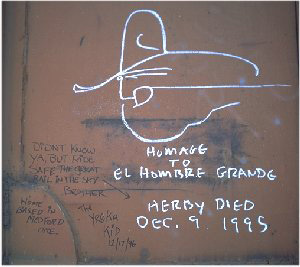
Colossus of Roads. Photo © buZ blurr
I was curious about your family and their attitude about everything you’ve been involved with, or even the level of their awareness of what you've been doing.
Well, in a way this is a real small conservative town, and I kind of have a reputation of being a real kind of strange oddball. So for that reason alone they try to fit in; try to be more square, straight-forward, good citizen types. So I mean, in that regard it was good that they didn't become too anti-social. [ed. note: See buZ's son Blake's response below] The one thing is, my occupation working night jobs on the railroad and not having much community interaction plus my art attitude of being a loner, folks are kind of suspicious of me being a weirdo. Anyway, they decided to compensate by being more civic minded or school oriented. They try to fit in instead of being an outsider like I always felt like. Of course I had to go to so many different schools from when I was a high school student. In junior high every year I went to a different school and I felt like an intruder or outsider everywhere I moved, so that also contributed to my avoidance of people and participation. They tried to fit in and I think felt more at home in this small town and enjoyed an upbringing in this small town.
Have they been supportive? Were they aware of the extent of your fan base or who was aware of or affected by your work?
Well of course part of my documentation, my Autostoricizzazione, has been the documentation of our life, and so they do have their life story in photographs. So that's been a plus for them. In that aspect they enjoyed my strangeness.
Is your wife now the girl you were talking about being engaged to in the ninth grade?
Yes. We'll have been married 44 years this Christmas eve. We have children that are 42, 39, and 38.
Is your wife artistic at all?
No, she doesn't have that pretense. She mainly has to herd me around now that I’m kind of old and borderline senile.
Did you ever have the desire to ride the rails other than as a paying passenger?
I guess I was too much of an essentialist to want to spend too much time riding in a boxcar. The romanticism of it…well, riding in the caboose after so many miles becomes boring in the comfort of a seat, watching the train ahead you know, so...
Well I did do a couple of hobo journeys when I was in the middle of the ninth grade, but that was a short distance. It was in a small town in eastern Arkansas, about 36 miles from Memphis, and it was in the cotton growing part of the state. So every town had cotton gins and a compressor where they would compact the cotton into bales. They'd store them and they'd ship the cotton in boxcars in bales, and the local would stop in this town and pick up cars out of the compress. So we'd, with a friend of mine, we'd hop a car on Saturday morning and ride into Memphis 36 miles, and would pull into the yards right near downtown and just explore Memphis, walk the streets. We’d check it out, and then we'd hitchhike home in the afternoon. So we did that a couple Saturdays, and that was the extent of my hobo experience. I was more impressed with downtown Memphis than I was with the train ride over, but of course you know, my dad was a minor railroad official, what they called then a “road master” and so I mean, it would have been a sure enough no-no for me to have gotten caught. And the same with my...being a graffiti vandal was also real counter to the idea of being a boss man, a controller of, in particular railroad discipline.
Was that ever talked about in your family?
He never scolded me. He became aware of it, but this was after a minor estrangement as a result of my parents’ divorce. Chalk graffiti was prevalent on the cars even back then, so at that point it wasn't considered a pervasive problem the way it is considered today, with the huge pieces and the obscuring of the air dates and car numbers and all that you know.
Do you think because of the direction it's heading, it's gotten bigger and bolder, and coupled with the security situation since 9/11 and the new types of trains too, is it a dying tradition?
I think that there are more people indulging in the spray pieces than in the monikers. And of course, with spray they have the protocol that a large piece supersedes everything, so they cover each other and everybody else too. I don't know where it's going. Certainly [with] the security and hysteria of 9/11 and Homeland Security and the pervasiveness of cell phones out there, it is kind of scary...and the increased security on the railroad too has certainly added to my apprehension.
And finally, does 'Babylon Falling' have any meaning to you?
Well of course the connotation of Babylon as the oppressor or the real anti-Christ, the scourge, and well, tearing it down sounds like a good idea.
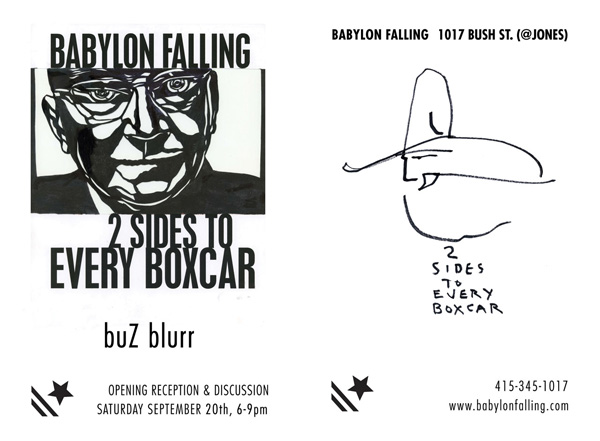
*buZ's son Blake Butler responds:
"My childhood was filled with interesting people and crazy activities. I became an active participant in some of his video work during my youth, allowing me to destroy televisions with sticks and bowling balls. We shot firecrackers off our helmeted heads while video taping the reactions. We were his available subjects to "hold this", "do that", or "film this". Though we lived the small town life, through Dad's work, his travels, and his connections with the rest of the world, we were transcended to other cultures and lifestyles. His activities shaped who we are more than he'll ever give credit. Dad mascaraed as an average railroad man to most, just as I mascaraed as a "square good-citizen" with the deviant just below the surface; never quite fitting in. Which is just the way I like it."